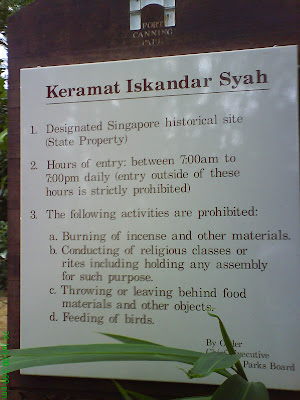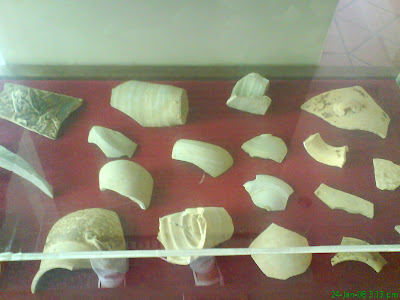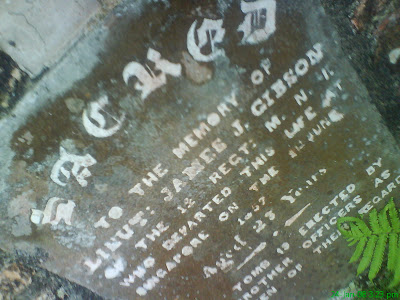Saturday, February 9, 2008
Thursday, February 7, 2008
::Jacelyn's Reflection::
At the end of the trail, I was very exhausted and almost burnt due to prolonged exposure to the UV rays. Simply put, it was extremely hot in the whole of that afternoon.
But still, despite the unbearable heat, I really enjoyed this heritage trail together with my group mates – Malinda, Leonard, Amelia and Zong Lun. They made me forget (temporarily, though) about the strong heat and my tiredness, and they all had been a great help. For instance, I practically depended on Zong Lun and Leonard to navigate the way and lead us, safely and soundly, to our finishing point. They are really good at reading maps! Also, my digital camera failed on me just as we began the trail. Thankfully, the rest of them had brought their own cameras and so we were able to take many fabulous pictures of us and the sites.
But most importantly, at the end of the trail, I have definitely learnt something about the history of our country. For instance, I was unaware that the Victoria Theatre and Victoria Concert Hall was the place where our government, the People’s Action Party (PAP) was founded. I was therefore enlightened while we were there. Although I have visited the place before, and had even performed at the Victoria Concert Hall during my secondary school days, I did not give much thought about the origins of the memorial hall back then, until this heritage trail came along.
Also, this heritage trail provided me a great opportunity to visit some of the national monuments and historical sites. For instance, it was actually my first visit to the Civilian War Memorial. I have always known about its existence, but to be really there physically and take in the magnificent view of the memorial was remarkable. Hence, this particular site is one of my favourites among the rest because it struck me the most. My mother used to tell me stories about my grandfather during the Japanese Occupation. He had gone through the war and witnessed the cruelty of the Japanese soldiers towards the civilians back then. I cannot imagine the kind of terror and fear the people back then had to endure when they were about to be killed. Hence, I think it was a brilliant decision to erect the memorial as a tribute to those who had perished during the war, so our future generations will always remember the horrors of the war and the importance of staying united in defending Singapore.
I was also impressed during the visit to the Arts House. Again, that was my first time there. Inside the Arts House, I walked down the Corridors of Time Gallery that traces the building’s conversion from a courthouse to a Parliament House. Among all the exhibits, I was particularly attracted to the “Pioneer Women in Parliament” display. So we women do have a say in the birth and growth of our independent legislative system and Constitution. But I think not many people now would know about their contributions in the past, as I believe much of their limelight was overshadowed by other politicians who are or were more renowned.
All in all, this heritage trail has definitely spiced things up a bit for this module. I can tell my family and friends that history is absolutely not a boring subject, not when we get to go for outings in search for our own identity, roots, and heritage. Also, this heritage trail has provided me an experience to plan for a class outing, should I need to organise one in the future. =)
::Zong Lun's Reflection::
On embarking this trail, I had a sense pessimism about I would be able to learn from this trip. After all, I have been educated within the context of the Singaporean education system on a narrow perspective of the historical happenings of colonial Singapore since secondary 1. What deconstructed my beliefs was when we started walking from one point to another and I could pick out the various historical significances from my point to another did I realize that what valuable and rich history do we have.
Yes, we might not have a history as far stretching as those of Europe, China or even America. But from this heritage trail, I got to touch, see and understand (short of taste and smell) the social, economic and political aspect of Singapore short but yet vibrant history for a city. From the viewing of the Dalhousie Obelisk which reminded me how early Singapore derived its economic prosperity, to the Tan Kim Seng fountain which Victorian iron- caste design made it so ironic that for a moment I thought the fountain was more to commemorate the building of James Mac Ritchie’s reservoir from which changed my perspective that it was a immigrant who had the visions for a water system for the early town, to the steps of city hall where the signing of the surrender instrument took place for WW2 and then of course we had the humorous discussion of Prof. Blackburn’s previous module on biography on the famous ‘Goh Chok Tong’ scene where school girls were cheering the ‘Chok Tong’ cheer along the steps of city hall on his swearing in.
The trail on the whole allows one to feel that you just reviewed through Singapore’s history from it conception at the landing site of Raffles, through the World Wars, independence, government; and it takes you back to the very beginning at Fort Canning where it all started within 3 hours (we walked really fast and have pictures to prove it that we were sweating, panting and literally ludicrous due to the lack of water: Look at Leonard’s self posing pictures).
On the whole the heritage trail has revived my interest in Singapore history and has offered me a wider perspective to things which I used to believe was merely ‘propaganda’. I also have grew closer and understand my team mates better as we were all very excited and enthusiastic history students who are on their first time field trip on ground. We hope that we will get more chances to do more ground work; which will help us understand and develop whatever we learn in the classrooms and text books.
ZongLun
=)
::Amelia's Reflection::
I personally do not feel that the trail was cheesy at all. In fact, I feel more like a history student now than before. My favorite part of the trail was The Arts House and Fort Canning Park. I think along the trail we didn’t get to learn much about the history behind each site on the spot, but for some reason seeing the old buildings, architecture, and artifacts, brought me a step closer to the history of Singapore. I realize now history is a part of our everyday, all around us, only if we care to pay notice; not just a time long gone.
After the trail, I was tasked with the research of Victoria Theatre and Victoria Concert Hall, Cenotaph, and The Old Supreme Court. It was interesting. Like, before the Old Supreme Court was erected, in its place stood a hotel known as the Grand Hotel de l’Europe, in 1900. And, the PAP was founded on 21 November 1954 in the Victoria Memorial Hall which is now known as the Victoria Concert Hall. Places and people. Places come alive with the stories and happenings people bring to them. It would be a pity if such places of historical value slowly lose their place in modern Singapore.
I think it’s a good thing the government makes an effort to gazette these places as National Monument. There are also plans for the Old Supreme Court and City Hall to be transformed into the National Art Gallery of Singapore by 2012. I think this is a promising move, for both history and the arts scene in Singapore.
To quote a Sunday Times article titled “Reclaiming the past for the future” by Janadas Devan, “If Singapore is to have a renaissance, its artists and writers, its scholars and thinkers, its art patrons and spectators, will have to [make new what had been handed on to them by tradition;] their own gifts from the past.”
::Malinda's Reflection::
At the end of the whole trail, we were all extremely tired, especially so for the 3 members of our groups who had to rush back to school for classes after the whole thing. But, nonetheless, the whole trail had been fulfilling and meaningful because I never knew the real story behind those architectures we have visited. And given the opportunity to find out more about those architectures, further deepen my understanding, as well as appreciation of Singapore even more.
To me, I believe that those buildings and architectures was built for a greater meaning besides memorial purposes, and I think that they were erected in a place like Singapore was so that to show others, despite our smallness in terms of country size, we do have a history, we do have roots to trace back to. Hence, this then provides not only the foreigners, who are ignorant of our cultures or heritage, but also the locals, especially the younger generations, an understanding of Singapore’s past.
Lastly, I just want to say that the site which gave me the most lasting impression would be the Fort Canning Park, because it is a place which had many memories due to the fact that quite a few key events happened there, such as Japanese Occupation where the British held base at the Park. Not only that, the place also contained many memories of the dead whose names were left on the boundary walls of the Fort Canning Park. So to me, I thought that Fort Canning Park was a nice place and I really like it. (:
::Leonard's Reflection::
Having gone through the civic district, I was left with a feeling of awe. Little did I realise that the sites chosen were largely along the Singapore River. This highlights the significance of the river and its position as the focal point of political and economic activity and even to some extent diplomatic activity. This can be expected as sea trade was the only means of transportation around the world till the invention of air travel. Even then, the sea lines of communication remained a popular avenue of communications and transport by many during the 1800s and early 1900s. Therefore having these important buildings around the river reflects the importance of the river as the major political and economic centre in the era. Also given that the lands first given to the British are the lands surrounding the river, it is totally understandable that the infrastructure would firstly be concentrated in areas of British control.
These sites indeed give sufficient understanding to the history of Singapore. While plagues and markers are left around the monuments, it gives a very touristy feel to the area and the explanations are not adequate enough for an in-depth understanding of the history. However, if you are someone looking for little tidbits of Singapore history and the monuments, a tour of the civic district is indeed a nice plan to have in your programme.
In addition, the well restored buildings retain almost all of its structural design and it gives a very good feel of how buildings are designed in the early days of colonisation. Indeed, I do hope more and more historical monuments are able to be preserved, it would give a very good insight into the history of Singapore. What can be a better way to show the history of our colonisation than to have a walk around the civic district and have a feel on how it was like during the days of Singapore being a colony.
At the end of the day, I feel that this trail that we have embarked on indeed gives a much deeper insight into the history of the nation. Never did I expect early Singapore to have deep diplomatic ties with other South East Asian Nations such as Siam. The willingness of a ruling monarch to visit this dinghy little island speaks volumes of the diplomatic ties involved. I guess this heritage trail thingy should not be just a tourist attraction. Singaporeans should take time and have a good look around the area and maybe they would come away with a profound appreciation of our history, just as I did.
Tuesday, February 5, 2008
17. Fort Canning Park (by Malinda)
Our last stop:
Now you know why we are so happy... =)
Fort Canning Park, once known as ‘Forbidden Hill’, is the most historic part of Singapore, where Malay and Chinese historical records indicated this hill as the center of a kingdom that arose around 1300AD.
Located within this park are a few places of interests, one of which would be the Keramat Iskandar Syah. A Malay meaning for sacred, the Keramat is the traditional burial ground of a well-known and respected leader. The place has a 14th century-styled Malay roof called a pendopo, supported by 20 wooden pillars carved in a fighting cock motif of Javanese origin.
Besides that, our group has also discovered some archaeological excavation sites where thousands of artifacts were uncovered, which then provided us with evidence that Fort Canning was a significant place even before the British arrival.
Some legend about Fort Canning Park: it was built by the British in the 1920s as headquarter for the Far East command and the office of Lt. - General Percival. In 1966 the Singapore Armed Forces(SAF) converted the building into its premier training institution, or so known as the Singapore Command and Staff College.
Nonetheless, the place is currently used as a town club, where it is open to public. Not only that, Fort Canning Park is also now commonly used as a place for wedding photos background! (:
But not to forget, as we were walking out of the park, we noticed the cupolas and the tombs on the boundary walls. The cupolas are still standing prominently in the park with not much damage to it. However, the tombs along the boundary walls were covered by mosses and some names were quite difficult to read. I noticed that most of the tombs belonged to Europeans (of course, for it is after all a Christian cemetery) and they seem to have some sort of achievements. How amazing.
We also made some interesting discovery along the way: Comics!
Hahah.
16. The Arts House (by Leonard)
The Arts House, formerly known as the Old Parliament building remains as one of Singapore’s National Monument. Built in 1827 by G.D Coleman, it is one of Singapore’s oldest surviving building and it was used to house the Court and other government offices until 1965 when it became the parliament house.
Inside, you can walk up the steps into this gallery area known as the Corridors of Time. The exhibits give interesting information on the parliament and there was even a section on Women in Parliament. It is an interesting area of history which many of us tend to neglect as we scrutinize the events of our nation.
Last page of the Treaty between Sir Stamford Raffles and Sultan Hussein dated 6 February 1819...
The door that opens up to power...
Interestingly, right at the current area of the café stands a small bronze elephant statue. According to the inscriptions on the statue, it was given to Singapore in 1871 from King Chulalongkorn of Siam(AKA Thailand) on his visit to the island of Singapore. Surprisingly, it seems that as early as in the late 1800s, Singapore already had diplomatic relations with other South East Asian nations.
Some interesting displays outside The Arts House...
Subscribe to:
Posts (Atom)




















































